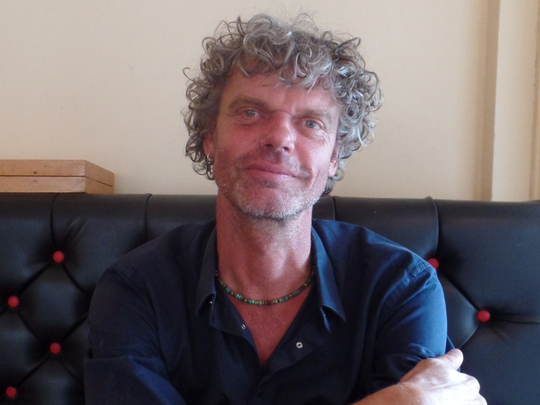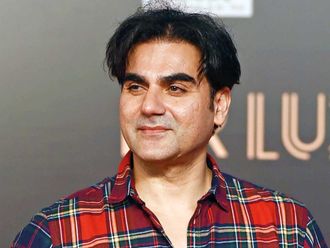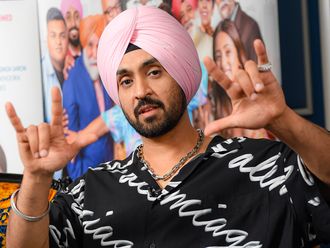
Immigration is a hot topic in the media at the moment. Whether its news stories of Syrian refugees escaping conflict, Libyans sailing on rickety boats to Europe or heated debates among American presidential hopefuls on how to treat “illegals” — the age-old phenomenon of people moving from one geographic location to another in search of a better future continues to impact societies around the world.
One man whose work dispels common myths about migrants is Kadir van Lohuizen, a Dutch photojournalist who, over the decades, has covered many conflict zones in Africa and other regions of the world. In his photographs immigration occurs as a recurring theme.
“We in Europe consider it normal to move to the US,” he tells Weekend Review. “That’s like the attitude that you have the right to move. But if somebody is from Nigeria or Congo, suddenly [they] don’t have that right. So, who makes these standards? I think that is a big issue the world in general, and Europe in particular, has to deal with at the moment. Because people are desperate, you know.”
I meet van Lohuizen one afternoon at Captein & Co, a canal-side café in Amsterdam.
“You must be wondering about my name as well,” he says. “It is Arabic. I was raised as a Sufi. My grandparents were Sufis. They converted to Sufism in the 1920s.” His brother and father also have Arabic names.
When travelling to the Middle East and elsewhere, his name sometimes is the subject of much curiosity. “Often, it is just interesting and funny but sometimes it’s problematic.”
When is it problematic? “While entering Israel,” he laughs. “They are always interrogating you, asking you the same questions.”
It touches on the question of identity. “Now you find a lot of people with Arabic names. But when I was a child, no one had an Arabic name, so I wasn’t answering to the standards of the Dutch model. But later, I started to understand it much better.”
Van Lohuizen was born in the Dutch city of Utrecht. He was interested in photography from an early age. When he was in high school, he built a darkroom in his parent’s cupboard. After finishing high school, he applied for a photography course, but his application was rejected.
Instead he worked as a sailor and later set up a shelter for the homeless and drug addicts. “I became socially conscious at quite an early age because I saw how people can drop out of the system.”
Then in 1985 he travelled to China. “There I rediscovered the camera. And I discovered that the camera was a tool to tell stories.”
He began his career as a photojournalist while visiting Palestine in February 1988, just after the start of the first Intifada. “You have to understand that the Netherlands has a big guilt thing going on,” he says. “You know what happened to the Jews in the Netherlands? A lot of Jews from Amsterdam were deported and killed. How much the Dutch actually did to prevent that is a bit questionable.”
This history had its impact on later perceptions of Israel. “When I was young, Israel was supported in every possible way. It was impossible to criticise Israel. So when the first Intifada happened, I was curious. Also I wanted to tell the story of Palestinians and was curious as to what motivated them to rise up.”
In Palestine, he took images of the colonies and narrated the stories of people in Gaza and the West Bank, where he encountered a lot of poverty. There weren’t many photographers in Palestine at that time and his images ended up being extensively used in the media.
“When I was in Gaza, there were 700,000 people. Now the population has almost doubled to about 1.5 million. But at that time, the camps perhaps looked more like camps. You could still see a little difference between the city and the camp. But not anymore. It is part of the Gaza city. We don’t know where the Jabalia Camp starts and ends.”
Van Lohuizen lives in the Lombok area of Utrecht, which has a very large percentage of immigrants. The majority of the immigrants in the Netherlands is from Suriname, Morocco and Turkey, who came here in the 1960s. In 1993, van Lohuizen got a chance to write a proposal to follow a family of Moroccan descent for a year. “It was not easy to find a family because obviously, to ask a family ‘can I follow you for a year?’ is quite a [tough] job. It took a while before I found a family that was willing.”
The Rharib family, whom van Lohuizen photographed, consisted of Ali, his wife Laila and five children. Ali had been employed as a guest worker in the Netherlands since the 1960s. Laila worked at the local community centre. Van Lohuizen spent a year with them documenting their life in the Dutch society.
“I went with them to Morocco — not really a holiday — [ they were] visiting family,” he says. The photographs of the family were displayed in an exhibition.
Then in 2013, he visited them again for three-four months to find out what had changed. “When I photographed them, they were the first and second generations. They were the ones that came from Morocco. Now, we are already talking of four generations.
“So in general, the children from the first generation are Dutch. They have Dutch nationality but we still call them Moroccans or Turks. To a certain extent it is true but the question is, when are you accepted as being Dutch? It is not just the Netherlands, but many societies too have to think about this. The world became very global. Mobility has increased enormously over the last couple of decades,” he says.
Questions about identity were one of the themes. “It was clear. Already at that time, the kids felt that when they were here, they were called Moroccan, and when they were in Morocco they were seen as Dutch. So there was a problem with identity. Where do I belong? Am I being accepted? So it was very important to revisit them.”
When he went back to meet the Rharib family, Ali had died. Van Lohuizen remembers him as someone who worked really hard. “He had, like, three jobs trying to take care of his family. But I could see their struggle with identity. The second daughter who was perhaps 10 at that time would watch her mother sometimes wear a scarf. The daughter would say, ‘don’t be crazy, don’t put it on.’”
That has changed. “Now the daughter is very religious. I cannot enter the room if she is not wearing the scarf. Obviously I did talk to her. In the end she said Islam was her help and she really believed that she wanted to be religious. At the same time, I think it is also an identity thing. I don’t think she ever felt completely accepted by the Dutch society. And she does feel accepted by Islam and the Moroccan community.”
The guest workers who came to the Netherlands initially were from poorer areas of Morocco and Turkey. “Not many came from cities ... [I found that] the Moroccans in Morocco in general are much more progressive than a lot of the older generation Moroccans you would find here.”
Van Lohuizen’s pictures of Ali and Laila’s family were displayed in a large exhibition 20 years ago. What was the response? “In general it was really good although the most responses you get are from people who are open-minded. I am not sure the narrow-minded people would see [the photos]. But the [photos] are shown at the museum here, and many schoolchildren visit it. I think that is really valuable, because everything starts with the children.”
Van Lohuizen has visited about 135 countries so far. His clients include the “New York Times”, “Time” magazine, “Geo” magazine in France and the Spanish newspaper El País. “I publish in the Netherlands as well but I couldn’t possibly live off the Dutch market alone. I have to publish internationally.”
He is also a member of NOOR (Arabic for light) photo agency which he co-founded with other photographers in 2007. “We felt that with digital revolution and with the change in the media market we needed to join forces and decide on our own future.”
Van Lohuizen has won many prizes, including a Zilveren Camera, two World Press Photo awards, a Dick Scherpenzeel prize, a Kees Scherer prize for best photo book and a PDN Annual Award.
I am curious about how his Sufi background influenced him. “Sufism in this part of the world has developed as a universal religion. The philosophy is to pick out the good things from all the religions. If you go to a Sufi service in the Netherlands, they will read from all the holy book — the Quran, the Bible and scriptures from the world religions. Everyone is influenced by his parents.”
When Van Lohuizen and his brother left home to study his parents would spend part of the year in India. Sufism has deep roots in Basti Nizamuddin in Delhi. “I would see my parents there sometimes,” he says.
His parents ran different projects in Delhi. “It is a very poor area in Delhi. [They ran] a project for women and child medical health. But it is a very close community there. It is funny. If I visited my parents there, my mother would wear a headscarf, and the women knew her.”
He recounts an assignment he was given while on a trip to India. “‘Newsweek’ called me. They knew I was going to India, they waited until I landed. They asked, ‘You are in Delhi, can you do a portrait of Delhi?’ I said, ‘Great! How much time do I have?’ They said, ‘Three days.’ I said, ‘You want me to do a portrait of Delhi in three days?’ If I told you to do a portrait of New York in three days, you’d tell me that’s a crazy idea. You can’t do a city in three days.”
He decided to focus on Basti Nizamuddin. “I had incredible access through my parents. There is normally no access to foreigners, but I could be there in a mosque even during prayers.”
Among the projects he has worked on is one in which he travelled along the seven major rivers of the world in 1997, documenting the daily life around them. In 2004 he visited Sierra Leone and Congo to document the journey of diamonds from mines to the consumers in the West. The result was the photobook “Diamond Matters”.
More recently he has worked on a project about the impact of rising sea levels, for which he travelled to places as far apart as Miami, the Pacific and Bangladesh. According to one projection, 50 million Bangladeshis will have to be moved to higher ground because of rising sea levels in the near future.
“The number of people who will be displaced because of climate [change] is just incredible,” he says. “The word ‘climate refugee’ is not an official term. You can’t find it in the UN dictionary. UNHCR doesn’t cater to climate refugees. People don’t realise that you don’t have to wait for the water to reach [your home] to finally move out. You have to leave earlier because you can’t grow crops anymore, there’s no safe drinking water, all the essentials are gone.”
Does he foresee the same occurring in the Netherlands? “Although the Netherlands is below the sea level, its future is relatively safer because for centuries we have invested in coastal protection, dykes and other measures. But eventually, even the Netherlands will cease to exist.”
Another project, Via PanAm, was made into an iPad app. From March 2011 to March 2012, Van Lohuizen travelled from the very tip of south Chile to the very north of Alaska. “The whole idea was born from the fact people in Europe, and also in the US, see immigration as a threat. They see it as something abnormal. But all the people in the US are immigrants first of all. In the Netherlands, if you [go] back to your roots far enough, you are always from somewhere else.”
Van Lohuizen wanted to show how migration is normal. “Migration is as old as humanity,” he says. “There is nothing new about it. People have always been moving around.”
As he set out to meet people in South America, he assumed that most of the people planning to migrate would choose the US. “I didn’t meet a single person who said he wanted to go to the US. I had to correct my own idea.”
No one wanted to go to the US? “No. First of all because the economies in South America are doing pretty well. Second, people know that migration laws in the US are very harsh. They know that the trip is very dangerous, that they might either die on the way or get arrested and deported. And that the job market in the US, especially at that time, was really [expletive].”
In Central America, however, he did find many people trying to go to the US. “All the people I asked why said they were looking for safety. They were from Guatemala, Honduras and El Salvador, which are among the most dangerous countries in the world.”
Van Lohuizen also made the dangerous journey on the roof of the train with migrants from Mexico to the US. “That is like a suicide trip,” he says. “These trains get stopped and people get kidnapped, they get killed. It is super dangerous. People do this because they live in a really bad situation. They are willing to take the risk. This is also why people jump into a boat in Libya. I mean you don’t do that for fun, right?”
Syed Hamad Ali is a writer based in London.












